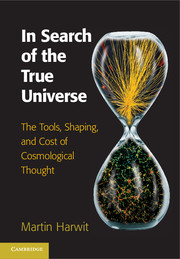Book contents
- Frontmatter
- Contents
- Preface
- Notes on Usage
- 1 The Nineteenth Century's Last Five Years
- Part I The Import of Theoretical Tools
- Part II A National Plan Shaping the Universe We Perceive
- 7 A New Order and the New Universe It Produced
- 8 Where Did the Chemical Elements Arise?
- 9 Landscapes
- 10 The Evolution of Astrophysical Theory after 1960
- 11 Turmoils of Leadership
- 12 Cascades and Shocks that Shape Astrophysics
- 13 Astrophysical Discourse and Persuasion
- Part III The Cost of Discerning the True Universe
- Epilogue
- Appendix: Symbols, Glossary, Units and Their Ranges
- Index
- References
7 - A New Order and the New Universe It Produced
Published online by Cambridge University Press: 05 December 2013
- Frontmatter
- Contents
- Preface
- Notes on Usage
- 1 The Nineteenth Century's Last Five Years
- Part I The Import of Theoretical Tools
- Part II A National Plan Shaping the Universe We Perceive
- 7 A New Order and the New Universe It Produced
- 8 Where Did the Chemical Elements Arise?
- 9 Landscapes
- 10 The Evolution of Astrophysical Theory after 1960
- 11 Turmoils of Leadership
- 12 Cascades and Shocks that Shape Astrophysics
- 13 Astrophysical Discourse and Persuasion
- Part III The Cost of Discerning the True Universe
- Epilogue
- Appendix: Symbols, Glossary, Units and Their Ranges
- Index
- References
Summary
July 5, 1945 marked a break in the way science and engineering were to be conducted in the United States in the postwar era. The government would take a leading role in the transition. The future was to belong to scientists and engineers working as teams partly dedicated to basic research, but more importantly working for the benefit of the nation, its security needs, its ability to feed its people, and the health of its children. This chapter recounts in some depth how and why the new program came to be initiated and adopted.
In the new arrangement, the future of astrophysics was nowhere mentioned, but time would show astronomy's emphasis on surveys and surveillance to be most closely aligned with military priorities. It took less than three decades to show that the alliance between the military and astronomers was leading to formidable advances no astronomer had anticipated. Soon other nations began to emulate the U.S. lead, and astronomy started advancing at a dizzying pace.
The contrast with astronomy before World War II could not have been greater.
Support for Basic Research in the Prewar Years
When Niels Bohr, during an impromptu visit from the young George Gamow late in the summer of 1928, assured him a year's Carlsberg Fellowship at the Royal Danish Foundation starting the next day, no senior physicist would have been surprised. When Bohr and Ernest Rutherford, the following year, asked the Rockefeller Foundation to provide Gamow a fellowship so he could work with Rutherford at Cambridge University, this too would have been expected.
- Type
- Chapter
- Information
- In Search of the True UniverseThe Tools, Shaping, and Cost of Cosmological Thought, pp. 121 - 156Publisher: Cambridge University PressPrint publication year: 2013



